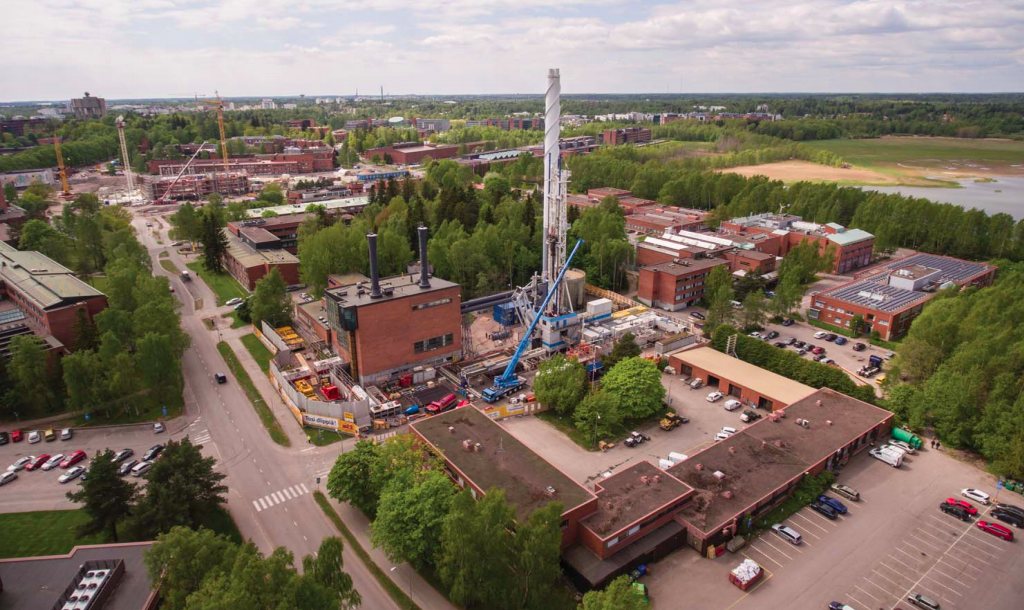Helsinki would need 5,000 wells for geothermal district heating
Researchers of Aalto University in Finland estimate that a minimum of 5,000 wells would be required for the district heating of the city of Helsinki.
The capital of Finland, Helsinki would require at least 5,000 intermediate-deep (around 2,000m) geothermal wells to meet the city’s demand in district heating. These are the findings of researchers at Aalto University, who are now calling for more studies.
Helsinki has been exploring ways to feed district heating with renewable energy sources, including geothermal. The deep geothermal project by St1 and a deep(er) geo-exchange system, paired with traditional geothermal heat pumps have been reported on. The goal was to utilise geothermal energy to provide district heating to cities and suburbs around Helsinki. A new study suggests that fields of wells connected to existing heating systems, instead of individual wells, should be studied.

Energy production with intermediate-deep geothermal wells is based on the existing thermal gradient in the bedrock. The gradient describes the temperature increase per unit length down a borehole. The lesser the gradient, the deeper the borehole must be to reach sufficient temperatures for energy extraction.
In volcanic areas, such as Iceland and California, heat is available near the surface but, in Finland, the thickness of Earth’s crust and its poor heat conductivity mean that depths of about two kilometres are needed to reach temperatures of 40-50 degrees Celsius. The wells replenish their energy with the heat from the Earth’s core but this process is very slow. In Finland, the heat flux in the bedrock from the depths to the surface is 0.05 W per square metre, about 2,000 times less than the average heat flux from the Sun at 100 W per square metre. Against human lifespan, the wells are non-renewable.
“The long-term potential of intermediate-deep energy wells should be studied more”, says Academy Research Fellow, physicist Eero Hirvijoki. He is a specialist in fusion reactors and plasma physics but was bothered by the lack of knowledge and decided to study the matter together with lecturer David Pfefferlé and Professor Manasvi Lingam. Instead of individual wells, their study examined the possibility of extensive fields of wells. This revealed a connection between longevity, achievable power, depth, and the surface area needed for the wells, or the power density achievable in the area.
“Cities have dense centres. When evaluating the potential of intermediate-deep energy wells, the required power density and the depth of the well together determine if enough of them will fit in the area and if they will be usable for a long enough time. Watts per square metre are the determining factor”, Hirvijoki says.
When seeking cost-efficiency, the aim is to drill as few wells as possible. However, an examination of a large field of wells indicates that the operational lifespan decreases with an increasing unit power.
“For example, if we want to get an average of 30 W per square metre, and wells three kilometres deep are selected with an output of 200 kW per well, the operational lifespan will be 50 years. If the power extracted from one well is reduced to 100 kW, the operational lifespan will reach 120 years. However, this would double the number of wells required.”
The sizing problem therefore has many dimensions. About 5,000 or 10,000 wells of the kind described in the example would be needed to heat Helsinki, depending on the well size. “The thinking has been that this would be an easy option, but the number of wells also requires the time to drill them. Major changes in energy systems do not happen overnight”, Hirvijoki says.
Hirvijoki hopes to inspire others to study the potential of energy wells. “It would be important to examine how intermediate-deep wells would work for seasonal storage. In the summer, when demand for heat is low, the energy wells could be charged using district heat produced in other low-carbon ways. In the winter, peak consumption could be reduced by utilising the heat stored in the well during the summer. At least the capacity factor of the district heating system would improve.”
David Pfefferlé, who has studied the dimensioning of energy wells with Hirvijoki, is a lecturer in mathematics and statistics in Australia, and Manasvi Lingam works as an assistant professor of astrobiology in the United States. The three got to know each other while working at Princeton University.
Source: Aalto University


















